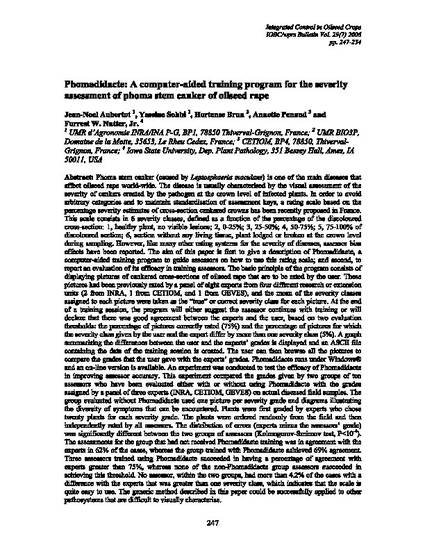
Article
Phomadidacte: A Computer-Aided Training Program for the Severity Assessment of Phoma Stem Canker of Oilseed Rape
Integrated Control in Oilseed Crops
Document Type
Conference Proceeding
Disciplines
Conference
Integrated Control in Oilseed Crops
Publication Version
Published Version
Publication Date
10-1-2004
Conference Title
Integrated Control in Oilseed Crops
Conference Date
October 11-12, 2004
Geolocation
(52.406374, 16.925168100000064)
Abstract
Phoma stem canker (caused by Leptosphaeria maculans) is one of the main diseases that affect oilseed rape world-wide. The disease is usually characterised by the visual assessment of the severity of cankers created by the pathogen at the crown level of infected plants. In order to avoid arbitrary categories and to maintain stsndardisation of assessment keys, a rating scale based on the percentage severity estimates of cross-section cankered crowns has been recently proposed in France. 1bis scale consists in 6 severity classes, defined as a function of the percentage of the discoloured cross-section: 1, healthy plant, no visible lesions; 2, 0-25%; 3, 25-50%; 4, 50-75%; 5, 75-100% of discoloured section; 6, section without any living tissue, plant lodged or broken at the crown level during sampling. However, like many other rating systems for the severity of diseases, assessor bias effects have been reported. The aim of this paper is first to give a description of Phomadidacte, a computer-aided training program to guide assessors on how to use this rating scale; and second, to report an evaluation of its efficacy in training assessors. The basic principle of the program consists of displaying pictures of cankered cross-sections of oilseed rape that are to be rated by the user. These pictures had been previously rated by a panel of eight experts from four different research or extension units (2 from INRA, I from CETIOM, and I from GEVES), and the mean of the severity classes assigned to each picture were taken as the ''true" or correct severity class for each picture. At the end of a training session, the program will either suggest the assessor continues with training or will declare that there was good agreement between the experts and the user, based on two evaluation thresholds: the percentage of pictures correctly rated (75%) and the percentage of pictures for which the severity class given by the user and the expert differ by more than one severity class (5%). A graph summarising the differences between the user and the experts' grades is displayed and an ASCII file containing the data of the training session is created. The user can then browse all the pictures to compare the grades that the user gave with the experts' grades. Phomadidacte runs under Windows® and an on-line version is available. An experiment was conducted to test the efficacy of Phomadidacte in improving assessor accuracy. 1bis experiment compared the grades given by two groups of ten assessors who have been evaluated either with or without using Phomadidacte with the grades assigned by a panel of three experts (INRA, CETIOM, GEVES) on actoal diseased field samples. The group evaluated without Phomadidacte used one picture per severity grade and diagrams illustrating the diversity of symptoms that can be encountered. Plants were first graded by experts who chose twenty plants for each severity grade. The plants were ordered randomly from the field and then independently rated by all assessors. The distribution of errors (experts minus the assessors' grade) was significantly different between the two groups of assessors (Kolmogorov-Smimov test, P<104 ). The assessments for the group that had not received Phomadidacte training was in agreement with the experts in 62% of the cases, whereas the group trained with Phomadidacte achieved 69% agreement. Three assessors trained using Phomadidacte succeeded in having a percentage of agreement with experts greater than 75%, whereas none of the non-Phomadidacte group assessors succeeded in achieving this threshold. No assessor, within the two groups, had more than 4.2% of the cases with a difference with the experts that was greater than one severity class, which indicates that the scale is quite easy to use. The generic method described in this paper could be successfully applied to other pathosystems that are difficult to visually characterise.
Copyright Owner
Jean-Noel Aubertot, et al
Copyright Date
2004
Language
en
File Format
application/pdf
Citation Information
Jean-Noel Aubertot, Yassine Sohbi, Hortense Brun, Annette Penaud, et al.. "Phomadidacte: A Computer-Aided Training Program for the Severity Assessment of Phoma Stem Canker of Oilseed Rape" Poznań, PolandIntegrated Control in Oilseed Crops Vol. 29 (2004) p. 247 - 254 Available at: http://works.bepress.com/forrest_nutter/56/

This proceeding is from Integrated Control in Oilseed Crops 29 (2004): 247. Posted with permission.